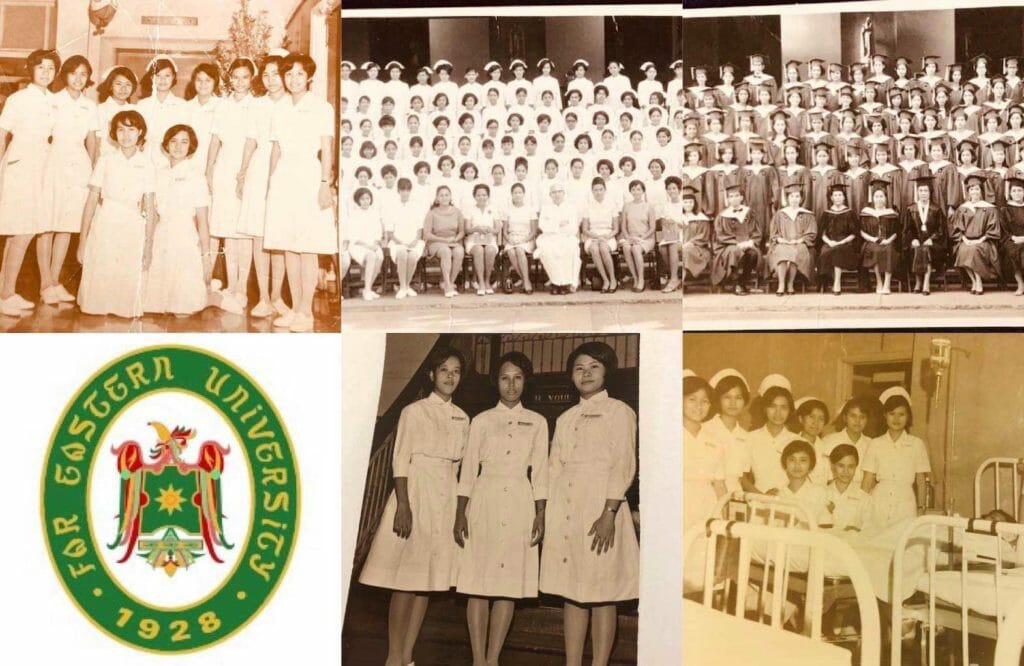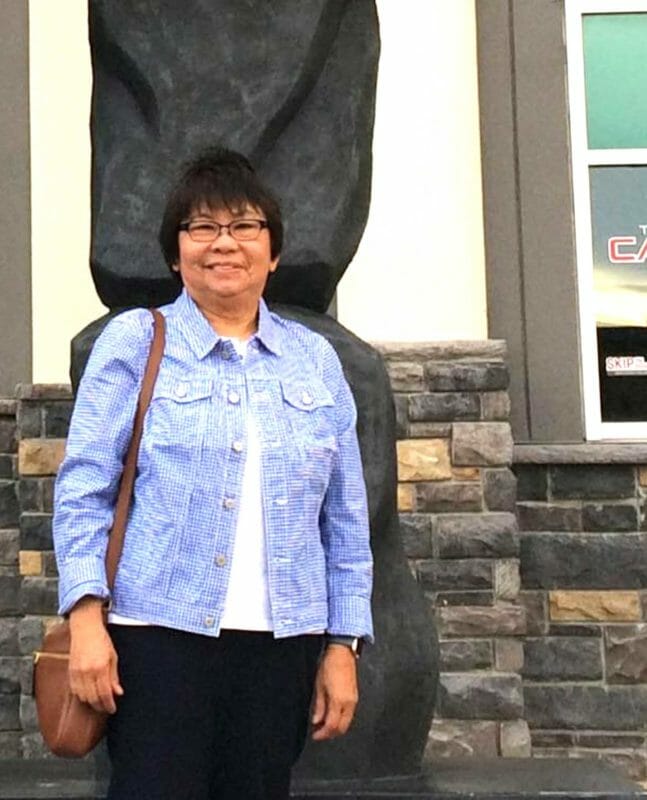Hiring PH-trained nurses in Canada hampered by barriers to credentials

Lucy Reyes’ graduating batch 1970 from Far Eastern University. CONTRIBUTED
RED DEER, Alberta – Hiring Filipino nurses remains an attractive option to fill the gap in health care for some provinces here in Canada, but the rigid process in acknowledging their credentials remains a barrier.
Stakeholders are confronting this challenged as Saskatchewan province in western Canada announced it plans to hire 150 to 300 health care workers from the Philippines in January, mainly for difficult-to-fill nursing positions.
Saskatchewan’s Ministry of Health is banking on the Philippines’ oversupply of health workers.
Previously, the province’s regional health authorities had successfully recruited some 300 nurses from the Philippines in 2007 and 2008. In its 2020 report, the National Nursing Assessment Service (NNAS), the not-for-profit organization that evaluates educational credentials of foreign-trained nurses in Canada, the Philippines was second to India in the number of applicants.
While Saskatchewan’s initiative was lauded, stakeholders are quick to point out that recruitment from the Philippines to fill the chronic nursing shortage may not be as easy as it seems.
Saskatchewan health authorities promise to do what they can.
Assist from the ministry
A spokesman for the ministry said the Philippine government requires a regulated recruiter broker the hiring for the employers, who will source candidates with the qualifications identified by the Saskatchewan Health Authority (SHA). The nurses will then be interviewed, assessed and hired within the Saskatchewan health care system.
In an email interview with INQUIRER.net, Jennifer Graham, spokesman for the ministry, said it would assist interested applicants to obtain licensure and would link them to employers offering jobs. Saskatchewan’s Ministry of Immigration and Career Training (ICT) would also take part in the project.

Lucy Reyes is a semi-retired RN who held many leadership roles in her 50 years of nursing. CONTRIBUTED
The Philippine Consulate General in Calgary will submit a template to the Saskatchewan authorities, which will contain a proposed government-to-government agreement for the recruitment.
“For candidates who do not meet licensure requirements, Saskatchewan Polytechnic offers the Registered Nursing Bridging Program for Internationally Educated Nurses certificate. Internationally trained nurses who require further education and training to meet licensing requirements may enroll in the program,” she said.
Eye opener
In 2008, Nikolai Macasaet, 37, was part of the wave of skilled medical workers who were directly hired from the Philippines to shore up Saskatchewan’s health care.
Macasaet had three years of intensive care nursing under his belt, working in a hospital in Pampanga, a central province some 79 km from the Philippine capital of Manila.
“My experience as an RN in the Philippines was an eye opener and overwhelming. I did not know how low the salary of an RN was when I was starting. I thought if you are a professional you can have at least acceptable salary but I was wrong,” he said, shedding light on an often-repeated reason why nurses leave the country.
“Financially, I cannot support my family needs the time. Working as RN in the Philippines you have tons of responsibility at work including the family, doctors and patient,” he said.
Nurses employed within the public health care system in the Philippines receive the highest average monthly salary of P13,500.00 (Cad $323), a measly amount compared with the average $5,890 in Canada.
When the opportunity to work in Canada came, Macasaet took his chances and was recruited through an agency.
“It was my first time and only time that I applied and got lucky right away. I did not have any idea what entails for me when I left the Philippines. My mindset that time was I needed to get out of the Philippines because the salary of nurses there is non-sustainable when you want to build a family,” he said.
Challenges in bridging
While Saskatchewan was not a personal choice for Macasaet, it provided a home for him to raise a family and flourish in nursing. The contrasting harsh weather condition in the winter and summer months was tolerable and racial discrimination was minimal if not non-existent, he said.
After 10 years of nursing in a major hospital in Saskatchewan, Macasaet transferred to a long-term care facility as a coordinator specializing in mental health program.

Nikolai Macasaet, 37, is a registered nurse who immigrated to Saskatchewan from the Philippines in 2008. CONTRIBUTED
“The biggest challenge for me when I first started is adjusting to the holistic care approach,” said Macasaet. Addressing patient care needs using an inter-professional approach was something he got used to.
A big plus for a nurse working within Canada’s publicly-funded health care is that medical care is not profit-driven – value is placed highly on providing quality care using best practices, he added.
“We don’t need to charge supplies, medical procedures and professional fees. Families are not worried about medical bills and can focus more on emotional and spiritual support for the patient,” he said.
Many, however, face a steep journey before getting fully licensed. It took three months for Macasaet to obtain his license as a registered nurse in Saskatchewan.
‘Not comparable evaluation’
Philippine-trained nurses generally receive a “not-comparable” evaluation when measured against the Canadian registered nurse education, and “somewhat comparable” to the licensed practical nurse education.
Overall number of immigrants in nursing and health care is in fact driven partly by the large number of workers from the Philippines, accounting for 10% of the total of nurses’ aides, orderlies or patient advocates, based on the 2016 survey by Statistics Canada.
Notably, up to 67% of these health care workers from the Philippines were also “overqualified” for the job, having completed their bachelor’s degree or having even higher level of education according to the survey.
Barriers in credentialing
Cashing in on the big opportunity for Filipino health workers, the Philippine government here offered to pitch in hoping to improve the outcome of credentials evaluation of Filipino nurses.
Consul General for Alberta and Saskatchewan Zaldy Patron discussed various options with Saskatchewan’s Health Minister Paul Merriman through a virtual meeting on February 14.
“I expressed [our] willingness to play a role if Saskatchewan would be open to a government–to-government arrangement for the recruitment of Filipino nurses,” said Patron in an email interview with INQUIRER.net.
The PCG in Calgary will be coordinating with the Department of Labor and Employment (DOLE) and the Philippine Overseas Labor Office (POLO) in Vancouver to help facilitate the process, he said.
Patron asked Minister Merriman for support for an easier recognition of credentials of Filipino nurses, an advocacy shared by the Philippine Embassy in Ottawa and the consulates general in Toronto and Vancouver.
A virtual meeting is being brokered between the Philippine’s Commission on Higher Education (CHEd) and the Saskatchewan government to discuss how this process can be eased and made more affordable and accessible for the Filipino nurses, especially those who are already in Saskatchewan.
“The support can come in the form of financial incentives, like what Manitoba offered,” he said.
In a bid to curb its nursing shortage, Manitoba province in July 2021 promised to increase nursing seats for internationally educated nurses, as well as up to $23,000 in cash incentive to help cover the cost of obtaining licensure.
“I also suggested a dialogue between the regulatory body of Saskatchewan and CHEd where we will have the opportunity to explain the competency of the Philippines’ nursing program. Hopefully, after the dialogue, Saskatchewan will have a better appreciation of the academic and clinical background of Filipino nurses applying for credentials recognition,” added Patron.
Patron also proposed the idea of having some courses of Saskatchewan’s nursing bridging program delivered in the Philippines through accredited Philippine nursing universities.
“We know that we have many nurses who are in Canada who are not able to practice their nursing profession due to several factors, such as lack of awareness on the process, the difference in the nursing curriculum of the Philippines and Canada, and the high cost of undergoing the assessment and the nursing bridging program in Canada, to name a few,” he said.
Further discussion also centered on this major barrier in a follow up meeting online on March 9, with Patron being one of the stakeholders including the Saskatchewan Minister of Advanced Education, Ministry of Immigration and Career Training, National Nursing Assessment Service, College of Registered Nurses of Saskatchewan, Saskatchewan Health Authority, and Saskatchewan Polytechnic.
Determination
To strengthen the competitiveness of the Philippine nursing education, esteemed Filipina-Canadian nurse Lucy Reyes proposes regular reviews of the nursing curriculum being offered by schools in the Philippines.
More exchange programs could also be established to facilitate world-class knowledge and training, she said.
Reyes, a product of Far Eastern University in the 1970s, was a recipient of the 2021 Most Influential Filipina Woman in the World in the Innovator and Thought Leader category following her remarkable career in nursing spanning over 50 years.
Reyes’ various leadership roles were instrumental in the opening of a 45-bed medical unit at the Foothills Medical Center, one of the biggest hospitals in Alberta, which utilizes IENs as staff to help ease their transition into Canadian healthcare system.
“The process for becoming recognized is better as we have the structure and processes established,” she said noting however that in Alberta, waitlisted IENs endure more than a year to get into a bridging program.
The need to provide for basic needs also takes priority, which sometimes weakens determination to pursue their dreams, she said.
“Determination is key. You have to prove your worth and keep on trying. To be competitive, you need to be twice as good as the other person,” she added.
For Macasaet, focusing on the goal to recoup that RN title would be a key. “Working here in Canada is very rewarding,” he said, whose wife also works as a RN in Saskatchewan.
He takes pride in Filipinos’ resilient quality especially in the caring field, citing a time when he came to work despite a severe snowstorm just to make sure the residents at the seniors’ facility were cared for.
Macasaet hopes the Philippine government regulates the salary of nurses whether in private or public sector to slow-down their exodus to other countries.
“It is not justifiable that as nurses their salary is very limited but the responsibilities to care for our fellow kababayansare very demanding. Nurses are burned out and under-appreciated so they are forced to leave,” he added.

